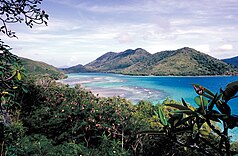Virgin Islands National Park
| Virgin Islands National Park | ||
|---|---|---|
|
|
||
| Location: | US Virgin Islands , United States | |
| Next city: | Charlotte Amalie , Amerik. Virgin Islands | |
| Surface: | 60.5 km² | |
| Founding: | 2nd August 1956 | |
| Visitors: | 112,287 (2018) | |
| Address: | Virgin Islands National Park | |
|
Map of the island of Saint John , framed in green: National Park |
||
The Virgin Islands National Park is located on the two Caribbean islands of Saint John and Hassel , which are part of the American Virgin Islands . After the tourism industry discovered St. John for itself, the national park was established in 1956 to protect against the threat of commercialization.
In the national park you will find sheltered bays with crystal clear water, coral reefs off the coast with the associated life, sandy beaches with shady coconut palms as well as the hilly and in some places mountainous hinterland of the islands with dense tropical forests that are habitat for more than 800 species of plants. Relics of the pre-Columbian population, Danish sugar plantations from the colonial times and evidence of slavery join this natural diversity . The area is administered by the National Park Service .
geography
location
The national park has a total size of about 52 km² and is located about 80 km east of the island of Puerto Rico in the Caribbean Sea . Most of the national park is located on the 14 km long and 8 km wide island of St. John, the area of which the park takes up to over two thirds. In addition, large parts of the offshore coast, as well as almost the entire island of Hassel, belong to the area of the national park.
geology
St. John and Hassel are volcanic islands that have arisen through repeated strong aboveground and underground volcanic activity and the associated gradual uplift of the sea floor, the cause of which is large-scale plate tectonic processes.
climate
The islands have a subtropical climate with high humidity and humid nights. The annual average temperature is 26 ° C, with temperature fluctuations between summer and winter being relatively small. Typically, more rain falls between July and January, while spring and summer are dry.
flora
The original vegetation of St. John was destroyed with the deforestation of the Danes and replaced by exotic, introduced plants. When the national park was created in 1956, only very small remnants of the original vegetation were found. The native plants have names such as Kapok , Teyer Palme , Lignum vitae , wild Frangipani , Bayrum , Meerwein and Gumbo Limbo . A multitude of colorful, also indigenous orchid species join these trees and bushes . Agaves and a few species of cacti thrive in drier parts . In some shallow bays, the deep-rooted mangroves form dense forests.
fauna
Native mammals are just the six different bat species . In order to get rid of the rats that had come to St. John on the ships of the immigrants, mongooses were released back into the wild in 1884 . However, contrary to all hope, this crawling cat species, widespread in Asia and Africa, did not feed on rats, but on the eggs of ground-breeding birds. 138 species of birds populate the islands today. There are also some species of lizards , frogs and sea turtles, as well as non-poisonous snakes, native to the area . However, the most diverse is the underwater world. The marine fauna of the subtropical shallow sea is inhabited by some types of coral , snails , mussels , starfish and many other marine animals.
tourism
The national park's most visited destinations are Annaberg and Trunk Bay . The Trunk Bay offers white sandy beaches and turquoise coves where you can do dives. In addition, the Virgin Islands National Park with its many beaches, coral reefs, historical ruins and hiking trails offers countless other opportunities to get to know the park and to do activities such as snorkeling , diving , hiking or bird watching. The visitor center is located on the west end of St. John Island at the port of the small town of Cruz Bay.
The national park can be reached by plane or by ferry. There are several hotels on the island of St. John. There is a campground at Cinnamon Bay.
The offshore Virgin Islands coral reef has also been a National Monument of the United States since 2001 .
Web links
- National Park Service: Virgin Islands National Park (official site; English)
- US National Parks Net: Virgin Islands National Park (English)



